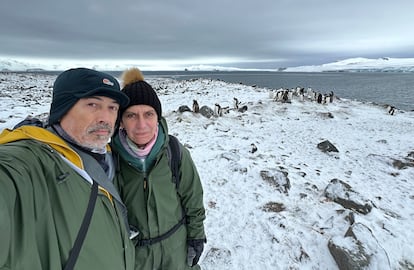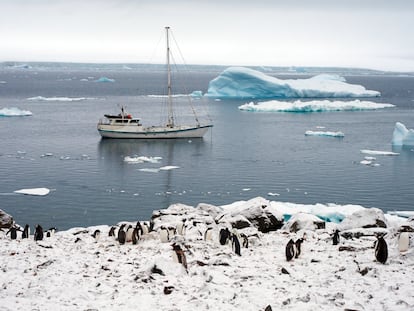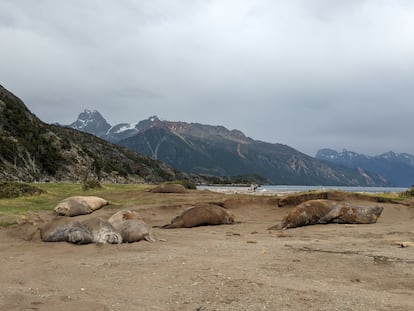Scientists discover ‘massive outbreak’ of deadly bird flu in Antarctica
An international expedition finds dozens of carcasses of skua, a scavenging bird, and shows that the disease is spreading across the planet’s southernmost continent. Hundreds of dead penguins were also found, although the presence of the virus in the bodies has not been confirmed

The lethal bird flu virus that has already killed hundreds of millions of birds around the world is spreading through Antarctica, according to a warning issued by an international expedition. Researchers aboard a vessel named the Australis traveled through the Weddell Sea for a month, collecting corpses of Antarctic skuas, migratory scavenging seabirds similar to seagulls. These were infected with influenza in four of the 10 areas that were analyzed. One of the researchers, Antonio Alcamí of Spain’s National Research Council (CSIC), explained by telephone that on Beak Island they witnessed “a massive outbreak” in a colony of skuas. “We saw 80 of them alive and 50 dead. That’s crazy,” warned the virologist, who works at the Severo Ochoa Molecular Biology Center in Madrid.
The finding adds to what already amounts to the worst avian flu crisis on record. A new subtype of the virus, called H5N1 2.3.4.4b, emerged in 2021 and has since led to the culling of hundreds of millions of farm birds and the deaths of millions of wild birds. The disease had spread across five continents and conservationists were holding their breath at the possibility that it might extend to Antarctica. On February 24, Alcamí and his colleague Ángela Vázquez confirmed the presence of the virus in Antarctica, in two dead skuas found by Argentine scientists and analyzed at the Spanish Antarctic base Gabriel de Castilla, on Deception Island.

Alcamí spent two months on a national mission and a month ago he joined an international expedition led by Australian scientist Meagan Dewar, of the SCAR Antarctic Wildlife Health Network. He and the biologist Begoña Aguado installed their diagnostic laboratory on the sailboat Australis in order to analyze the samples. “This had never been done before. We have shown that it can be done,” said Alcamí. The expedition, made up of 11 people, found skua carcasses in Hope Bay and on Devil’s and Paulet Islands, in addition to the 50 observed in the massive outbreak on Beak Island. Researchers tested 10 of the 50 samples and all of them were positive. Scientists from the Chilean Antarctic Institute (INACH) also announced on March 14 that they had detected the virus in five skuas on Ross Island.
The sailboat also explored Heroína Island, inhabited by a colony of Adélie penguins, which owe their name to Adèle Pépin, wife of the French explorer Jules Dumont d’Urville, who discovered these birds in 1840. The Alcamí and Aguado expedition found “a massive mortality” among these penguins. “We counted 500 bodies and stopped counting after that,” said the virologist, who estimates that there could be thousands of dead penguins. His team, however, did not immediately detect traces of the highly pathogenic avian flu viruses, despite analyzing the brains and lungs of the dead penguins.
Hundreds of sea lions with H5N1 flu, either dead or dying, began to show up on the beaches of Peru in January 2023, triggering fears that the virus would learn to jump from mammal to mammal. That terrifying possibility has not come true, at least for now. The pathogen still jumps easily from bird to bird, but when it reaches a mammal it is usually a dead end. The epidemiologist Vijay Dhanasekaran, from the University of Hong Kong, explained to this newspaper in October that humans must nevertheless remain alert. “There is a perpetual threat of the virus jumping to humans. This is mainly due to the virus’ ability to evolve rapidly. It can acquire mutations that help it adhere better to the receptors of human cells, or it can acquire the ability to be transmitted by aerosols,” warned Dhanasekaran. Alcamí and Aguado have analyzed sea lions and elephant seals, without finding any positive cases.
Sign up for our weekly newsletter to get more English-language news coverage from EL PAÍS USA Edition
Tu suscripción se está usando en otro dispositivo
¿Quieres añadir otro usuario a tu suscripción?
Si continúas leyendo en este dispositivo, no se podrá leer en el otro.
FlechaTu suscripción se está usando en otro dispositivo y solo puedes acceder a EL PAÍS desde un dispositivo a la vez.
Si quieres compartir tu cuenta, cambia tu suscripción a la modalidad Premium, así podrás añadir otro usuario. Cada uno accederá con su propia cuenta de email, lo que os permitirá personalizar vuestra experiencia en EL PAÍS.
¿Tienes una suscripción de empresa? Accede aquí para contratar más cuentas.
En el caso de no saber quién está usando tu cuenta, te recomendamos cambiar tu contraseña aquí.
Si decides continuar compartiendo tu cuenta, este mensaje se mostrará en tu dispositivo y en el de la otra persona que está usando tu cuenta de forma indefinida, afectando a tu experiencia de lectura. Puedes consultar aquí los términos y condiciones de la suscripción digital.











































